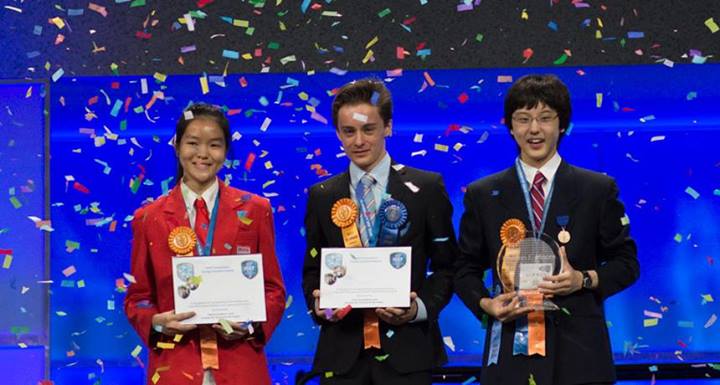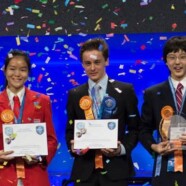15-year-old wins Intel top prize
Teen’s cancer research scores big at Intel ISEF competition
By analyzing public databases of cancer mutations, a freshman claims Intel ISEF’s top prize
An innovative statistical analysis of cancer-promoting genes could provide a new roadmap for scientists studying the disease. The technique, which could be applied to other genes as well, earned a 15-year-old researcher the top prize — and $75,000 — here, this week, at the world’s premier high-school science and engineering competition.

Big winners at this year’s Intel International Science and Engineering Fair include Shannon Lee (left), 17, from Singapore; Lennart Kleinwort (center), 15, from Würzburg, Germany; and Nathan Han (right), 15, from Boston, Mass. Nathan claimed the top prize of $75,000 for his cancer research; Shannon and Lennart each earned $50,000 for their winning projects.
Nathan Han of Boston Latin School in Boston, Mass., claimed first prize at this year’s Intel International Science and Engineering Fair, or ISEF. He was one of three young researchers who walked away with prizes worth at least $50,000.
Society for Science & the Public created ISEF in 1950. The Washington, D.C.-based organization still manages the competition. (SSP also publishes Science News for Students.) This annual event attracts some of the world’s most talented young researchers. There were 1,787 finalists this year. They were selected from among the winners at science fairs in more than 70 countries, regions and territories. Altogether, the finalists claimed more than $5 million in awards.
“Intel believes that young people are the key to innovation. And we hope that these winners inspire more students to get involved in science, technology, engineering and math,” says Wendy Hawkins. She’s executive director of the Intel Foundation. It is based in Santa Clara, Calif.
Intel ISEF’s top cash prize is named for Gordon E. Moore, Intel’s cofounder. Nathan Han earned the award this year for studying mutations in genes that normally suppress the growth of tumors. He surveyed public health databases, looking for reports of mutations in a particular gene related to breast cancer. These mutations affect the structure of proteins that should repair cell damage and stifle the growth of cancer. Ultimately, Nathan says, results of this research and other studies like it could identify gene mutations most likely to boost cancer risk.
“There’s a lot of publicly available data out there,” Nathan notes. “This project touches on everything I’m interested in: computer science, biology and statistics.”
Two other young researchers each received Intel Foundation Young Scientist Awards of $50,000.
Lennart Kleinwort earned one for developing a mathematics app for smartphones and electronic tablets. The 15-year-old researcher attends Friedrich-Koenig Gymnasium in Würzburg, Germany. App users can draw shapes on a virtual sheet of graph paper. Then they can move the shapes around, changing their sizes and proportions. Or, they can plot data on the device and instruct it to plot the most accurate fit. His app can be used for both education and research.
The app is designed to work efficiently even on devices with little computing power, Lennart says. Yet the software can handle everything from simple algebra to more complex math, such as calculus. It is suitable for everyone from high school students to scientists, he says. But most of all, the teen continues, “I wanted to create software that would let people have fun with mathematics.”
Shannon Lee, 17, of National Junior College, in Singapore, claimed the other $50,000 prize. She developed an inexpensive material that can be used as an electrode in some types of batteries. Those batteries now typically include an electrode made from a costly mix of platinum and carbon.
Shannon made her new material by heating eggplant at high temperature until it turned into charcoal. Then she soaked this highly porous carbon in potassium hydroxide, an alkaline solution. This dramatically increased the surface area of the material. That provides more places for chemical reactions to occur, she explains. The change could allow engineers to get the same performance found in today’s batteries from a smaller and lower-voltage device.
“In congratulating Nathan, Lennart and Shannon, we join with Intel in seeing great hope in their research and that of all of our Intel ISEF finalists,” says Rick Bates. He’s the interim CEO of SSP.
Best-in-category winners
Seventeen Intel ISEF teams or finalists won “best of category” awards. Each is worth $5,000. Nathan’s project earned first place in the medicine-and-health category. Lennart’s research claimed top prize in math. Shannon took home the top award for energy and transportation.
Other best-of-category winners include:
For animal sciences: Abhishek Verma, 15, and Daksh Dua, 16, of the Maharaja Agarsain Public School in Delhi, India. They showed that an herbal extract from the roots of a common shrub — the Himalayan yellow raspberry — helps treat giardiasis. This diarrheal disease is caused by a microbe often found in contaminated water supplies. Many drugs used to treat the disease have side effects. These can include nausea and dizziness. The new extract, however, would avoid those problems, the teens say.
For behavioral and social science: Michelle Marquez, 15, of the Math and Science High School at Clover Hill, in Midlothian, Va. She studied brain waves in people as they listened to music or other sounds. Her analyses revealed that relatively simple music and sounds seemed to trigger generally positive emotions. In contrast, people who heard complex music or sounds tended to show signs of fear or other negative emotions.
For biochemistry: Ken Aizawa, 17, of Jericho Senior High School in Jericho, N.Y. He analyzed the role of two proteins in boosting the growth of cancer cells. Drug treatment causes concentrations of one protein, called AKT, to drop dramatically. Ken showed that when this happens, levels of another protein — SGK3 — skyrocket. In other tests, he added drugs that decreased levels of both proteins at the same time. This caused cancer cells to die in higher numbers than before. This suggests that targeting both proteins might be a better treatment for certain types of cancer.
For cellular & molecular biology: Joshua Meier, 18, of Academy for the Advancement of Science and Technology in Hackensack, N.J. He studied how to prevent premature aging in certain types of stem cells. Stem cells are cells that can mature into any of many different types. Such cells could someday be used to treat a variety of common age-related diseases. Joshua’s tests identified 16 genes that have been linked with early aging of these cells. Targeting these genes might keep the stem cells younger longer. If that works, doctors might one day be able to prevent or delay ailments such as Parkinson’s disease, Alzheimer’s disease or diabetes.
For chemistry: Tai Hei Chan, 18, and Er Hai Fang, 17, of King’s College in Hong Kong, China. They developed a faster, cheaper and less invasive test for a kidney ailment known as chronic renal failure. The old test provides results in about 3 days. Their new one takes only 10 minutes.
For computer science: Yue Yao, 17, of a high school affiliated with Shanghai Jiao Tong University in China. He used three-color combinations of lights transmitted over fiber-optic cables as the basis for new computing techniques. Most computers use “1”s and “0”s transmitted over wires, which can heat up, wasting energy. The new methods could make computers faster and more efficient, he says.
For earth science: Yu-Hsin Chen, 17, of the Taipei First Girls High School in Chinese Taipei. Her analyses suggest that the average intensity of typhoons (hurricanes) in the western North Pacific has increased by about 10 percent in the past 20 years. The largest factor boosting their strength, she found, is an increase in the thickness of the layer of warm surface water throughout that region.
For engineering: electrical & mechanical: Sarah Galvin, 18, of Corona del Sol High School in Tempe, Ariz. She improved the performance of certain types of electronic components. Those devices have typically been built on a disk made from magnesium oxide. Its crystal structure was long presumed to offer the best match for the circuits laid down atop them. But magnesium oxide is expensive to work with. Sarah’s tests suggest that by making the base of these devices from silicon dioxide, the circuitry would be much cheaper. (Silicon dioxide is now used for many computer chips.) What’s more, such circuits perform almost 9 percent better, she reports.
For engineering: materials & bioengineering: Harry Paul, 17, of the Paul D. Schreiber High School in Port Washington, N.Y. He developed a device to straighten and stabilize the spines of children born with scoliosis, an abnormally curved backbone. Correcting the condition typically requires a dozen or more surgeries before adulthood. But Harry invented a titanium-alloy implant that can extend as a patient grows. That might reduce a patient’s surgeries to five or fewer. One additional benefit: It would cut the amount of scar tissue that forms as well as the chance of surgery-related infections.
For environmental management: Faye Jong, 15, of Sekolah Menengah Kebangsaan Batu Lintang in Kuching, Malaysia. She figured out how to use biowastes, such as fruit peels and discarded tea bags, as eco-friendly replacements for the synthetic dyes now used to color fabric. Some alternatives, such as mangosteen peels, worked just as well as chemical dyes, she found. This kind of recycling would keep many biowastes out of landfills. The natural products could also cut the need for many chemicals and reduce pollution, Faye suggests.
For environmental sciences: Perry Alagappan, 17, of Clear Lake High School in Houston, Texas. He invented a filter that uses carbon nanotubes to remove toxic metals from water. Such pollutants include lead, cobalt and cadmium. The filter can remove more than 99 percent of these metals from even very polluted water. And unlike other types of filters, he notes, the new device can be reused after washing it in industrial-strength vinegar.
For microbiology: Logan Collins, 17, of Fairview High School in Boulder, Colo. He developed a way to use cellular features called plasmids to deliver genes into bacteria that will stunt the microbes’ growth. The technique could be used as a treatment against bacterial infections. This treatment doesn’t use drugs. As such, Logan says, this approach to fighting germs could overcome the problem of resistance that occurs with many antibiotics.
For physics and astronomy: J. Chapman Caddell, 16, of Stevenson School in Pebble Beach, Calif. He showed that lopsided grooves on the inner surface of a pipe can act as a non-mechanical pump for boiling fluids. Those oddly shaped grooves interact with the layer of steam that forms on a pipe’s inner surface. They push any droplets in the pipe more in one direction than in another. Adding those grooves to pipes carrying water or other fluid through a nuclear reactor could help cool it in case of an emergency situation, such as when electrical pumps fail, Chapman says.
For plant sciences: Yi-Hsuan Huang, 17, of the Taipei Municipal Jianguo High School in Taipei City, Chinese Taipei. A protein found in all plants and animals affects flowering in a plant called Arabidopsis. Previously, scientists had suspected that the protein, called bZIP16, affected only the sprouting of the plant’s seeds. Yi-Hsuan showed, though, that it does much more. Plants that couldn’t make bZIP16 bloomed about 7 days later than plants that made normal amounts of the protein, he found. Plants that made excessive amounts of the protein bloomed earlier than usual. That showed the protein also helps control when a plant prepares for reproduction.
Intel ISEF finalists earned a slot in L.A. by besting their competitors at 435 local and regional science fairs affiliated with ISEF — an inspiring feat.
“Not only are they working to discover solutions for society’s challenges,” says SSP’s Bates, “they importantly serve as an inspiration for younger students and encourage them to become involved in the amazing world of hands-on science and engineering.”
Source: Sid Perkins / student.societyforscience.org

